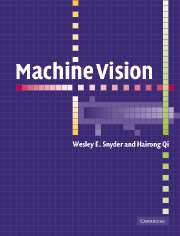Book contents
- Frontmatter
- Contents
- To the instructor
- Acknowledgements
- 1 Introduction
- 2 Review of mathematical principles
- 3 Writing programs to process images
- 4 Images: Formation and representation
- 5 Linear operators and kernels
- 6 Image relaxation: Restoration and feature extraction
- 7 Mathematical morphology
- 8 Segmentation
- 9 Shape
- 10 Consistent labeling
- 11 Parametric transforms
- 12 Graphs and graph-theoretic concepts
- 13 Image matching
- 14 Statistical pattern recognition
- 15 Clustering
- 16 Syntactic pattern recognition
- 17 Applications
- 18 Automatic target recognition
- Author index
- Index
8 - Segmentation
Published online by Cambridge University Press: 05 June 2012
- Frontmatter
- Contents
- To the instructor
- Acknowledgements
- 1 Introduction
- 2 Review of mathematical principles
- 3 Writing programs to process images
- 4 Images: Formation and representation
- 5 Linear operators and kernels
- 6 Image relaxation: Restoration and feature extraction
- 7 Mathematical morphology
- 8 Segmentation
- 9 Shape
- 10 Consistent labeling
- 11 Parametric transforms
- 12 Graphs and graph-theoretic concepts
- 13 Image matching
- 14 Statistical pattern recognition
- 15 Clustering
- 16 Syntactic pattern recognition
- 17 Applications
- 18 Automatic target recognition
- Author index
- Index
Summary
Galia est omnes divisa in partes tres
Julius CaesarSegmentation is the process of separating objects from background. It is the building block for all the subsequent processes like shape analysis, object recognition, etc. In this chapter, we first discuss several popular segmentation algorithms, including threshold-based, region-based (or connected component analysis), edge-based, and surface-based. We also describe some recently developed segmentation algorithms in the topics section.
Segmentation: Partitioning an image
In many machine vision applications, the set of possible objects in the scene is quite limited. For example, if the camera is viewing a conveyer, there may be only one type of part which appears, and the vision task could be to determine the position and orientation of the part. In other applications, the part being viewed may be one of a small set of possible parts, and the objective is to both locate and identify each part.?? Finally, the camera may be used to inspect parts for quality control.
In this section, we will assume that the parts are fairly simple and can be characterized by their two-dimensional projections, as provided by a single camera view. Furthermore, we will assume that the shape is adequate to characterize the objects. That is, color or variation in brightness is not required. We will first consider dividing the picture into connected regions.
A segmentation of a picture is a partitioning into connected regions, where each region is homogeneous in some sense and is identified by a unique label.
- Type
- Chapter
- Information
- Machine Vision , pp. 181 - 215Publisher: Cambridge University PressPrint publication year: 2004



